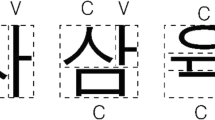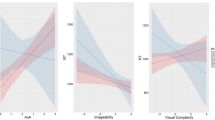Abstract
Differences between languages in terms of number naming systems may lead to performance differences in number processing. The current study focused on differences concerning the order of decades and units in two-digit number words (i.e., unit-decade order in German but decade-unit order in French) and how they affect number magnitude judgments. Participants performed basic numerical tasks, namely two-digit number magnitude judgments, and we used the compatibility effect (Nuerk et al. in Cognition 82(1):B25–B33, 2001) as a hallmark of language influence on numbers. In the first part we aimed to understand the influence of language on compatibility effects in adults coming from German or French monolingual and German–French bilingual groups (Experiment 1). The second part examined how this language influence develops at different stages of language acquisition in individuals with increasing bilingual proficiency (Experiment 2). Language systematically influenced magnitude judgments such that: (a) The spoken language(s) modulated magnitude judgments presented as Arabic digits, and (b) bilinguals’ progressive language mastery impacted magnitude judgments presented as number words. Taken together, the current results suggest that the order of decades and units in verbal numbers may qualitatively influence magnitude judgments in bilinguals and monolinguals, providing new insights into how number processing can be influenced by language(s).




Similar content being viewed by others
Notes
This is the range of number pairs used in the magnitude judgment tasks to observe compatibility effects.
References
Baayen RH, Milin P (2010) Analyzing reaction times. Int J Psychol Res 3(2):12–28
Bernardo ABI (2001) Asymmetric activation of number codes in bilinguals: further evidence for the encoding complex model of number processing. Memory Cogn 29(7):968–976. doi:10.3758/BF03195759
Butterworth B (1999) The mathematical brain. Macmillon, London
Cohen J, MacWhinney B, Flatt M, Provost J (1993) PsyScope: an interactive graphic system for designing and controlling experiments in the psychology laboratory using Macintosh computers. Behav Res Methods Instrum Comput 25(2):257–271. doi:10.3758/BF03204507
Dehaene S (2001) Precis of the number sense. Mind Lang 16(1):16–36. doi:10.1111/1468-0017.00154
Dehaene S, Spelke E, Pinel P, Stanescu-Cosson R, Tsivkin S (1999) Sources of mathematical thinking: behavioral and brain-imaging evidence. Science 284(5416):970–974. doi:10.1126/science.284.5416.970
Dijkstra T, van Heuven WJB (2002) The architecture of the bilingual word recognition system: From identification to decision. Biling Lang Cogn. doi:10.1017/S1366728902003012
Feldman LB, Kostić A, Basnight-Brown DM, Durdević DF, Pastizzo MJ (2010) Morphological facilitation for regular and irregular verb formations in native and non-native speakers: Little evidence for two distinct mechanisms. Biling Lang Cogn 13(02):119. doi:10.1017/S1366728909990459
French RM, Jacquet M (2004) Understanding bilingual memory: models and data. Trends Cogn Sci 8(2):87–93. doi:10.1016/j.tics.2003.12.011
Groen GJ, Parkman JM (1972) A chronometric analysis of simple addition. Psychol Rev 79(4):329–343. doi:10.1037/h0032950
Grosjean F (2010) Bilingual: life and reality. Harvard University Press, Cmbridge
Jacob G, Fleischhauer E, Clahsen H (2013) Allomorphy and affixation in morphological processing: a cross-modal priming study with late bilinguals. Biling Lang Cogn 16(4):924–933
Kroll JF, Stewart E (1994) Category interference in translation and picture naming: evidence for asymmetric connections between bilingual memory representations. J Mem Lang 33(2):149–174. doi:10.1006/jmla.1994.1008
Laski EV, Yu Q (2014) Number line estimation and mental addition: examining the potential roles of language and education. J Exp Child Psychol 117:29–44. doi:10.1016/j.jecp.2013.08.007
Macizo P, Herrera A (2008) The effect of number codes in the comparison task of two-digit numbers. Psicológica 29:1–34
Macizo P, Herrera A (2010) Two-digit number comparison: decade-unit and unit-decade produce the same compatibility effect with number words. Can J Exp Psychol 64(1):17–24. doi:10.1037/a0015803
Macizo P, Herrera A, Paolieri D, Román P (2010) Is there cross-language modulation when bilinguals process number words? Appl Psycholinguist 31(04):651–669. doi:10.1017/S0142716410000184
Macizo P, Herrera A, Román P, Martín MC (2011) Proficiency in a second language influences the processing of number words. J Cogn Psychol 23(8):915–921. doi:10.1080/20445911.2011.586626
Marslen-Wilson WD (2007) Processes in language comprehension. The Oxford handbook of psycholinguistics 11:175
Miller KF, Stigler JW (1987) Counting in Chinese: cultural variation in a basic cognitive skill. Cogn Dev 2:279–305
Miller KF, Smith CM, Zhu J, Zhang H (1995) Preschool origins of cross-national differences in Mathematical competence: the role of number-naming systems. Psychol Sci 6(1):56–60. doi:10.1111/j.1467-9280.1995.tb00305.x
Miura IT, Kim CC, Chang C-M, Okamoto Y (1988) Effects of language characteristics on children’s cognitive representation of number: cross-national comparisons. Child Dev 59(6):1445. doi:10.2307/1130659
Miura IT, Okamoto Y, Kim CC, Chang C-M, Steere M, Fayol M (1994) Comparisons of Children’s cognitive representation of number: China, France, Japan, Korea, Sweden, and the United States. Int J Behav Dev 17(3):401–411. doi:10.1177/016502549401700301
Moyer RS, Landauer TK (1967) Time required for Judgements of Numerical Inequality. Nature 215(5109):1519–1520. doi:10.1038/2151519a0
Neubauer K, Clahsen H (2009) Decomposition of inflected words in a second language. Stud Second Lang Acquis 31(03):403–435
Ngan Ng SS, Rao N (2010) Chinese number words, culture, and mathematics learning. Rev Educ Res 80(2):180–206. doi:10.3102/0034654310364764
Nuerk H-C, Willmes K (2005) On the magnitude representations of two-digit numbers. Psychol Sci 7(1):52–72
Nuerk H, Weger U, Willmes K (2001) Decade breaks in the mental number line? Putting the tens and units back in different bins. Cognition 82(1):B25–B33. doi:10.1016/S0010-0277(01)00142-1
Nuerk H-C, Weger U, Willmes K (2002) A unit-decade compatibility effect in German number words. Current Psychol Lett Behav Brain Cognit 7:19–38
Nuerk H-C, Kaufmann L, Zoppoth S, Willmes K (2004) On the development of the mental number line: more, less, or never holistic with increasing age? Dev Psychol 40(6):1199–1211. doi:10.1037/0012-1649.40.6.1199
Nuerk H, Weger U, Willmes K (2005) Language effects in magnitude comparison: small, but not irrelevant. Brain Lang 92(3):262–277. doi:10.1016/j.bandl.2004.06.107
Nuerk H-C, Moeller K, Klein E, Willmes K, Fischer MH (2011) Extending the mental number line: a review of multi-digit number processing. Zeitschrift Für Psychologie 219(1):3–22. doi:10.1027/2151-2604/a000041
Pixner S, Moeller K, Zuber J, Nuerk H (2009) Decomposed but parallel processing of two-digit numbers in 1st graders. Open Psychol J 2:40–48
Pixner S, Moeller K, Hermanova V, Nuerk H-C, Kaufmann L (2011) Whorf reloaded: language effects on nonverbal number processing in first grade—a trilingual study. J Exp Child Psychol 108(2):371–382. doi:10.1016/j.jecp.2010.09.002
Rastle K, Davis MH, New B (2004) The broth in my brother’s brothel: morpho-orthographic segmentation in visual word recognition. Psychon Bull Rev 11(6):1090–1098
Salillas E, Carreiras M (2014) Core number representations are shaped by language. Cortex 52:1–11. doi:10.1016/j.cortex.2013.12.009
Salillas E, Wicha NYY (2012) Early learning shapes the memory networks for arithmetic: evidence from brain potentials in bilinguals. Psychol Sci 23(7):745–755. doi:10.1177/0956797612446347
Silva R, Clahsen H (2008) Morphologically complex words in L1 and L2 processing: evidence from masked priming experiments in English. Biling Lang Cogn. doi:10.1017/S1366728908003404
Talamas A, Kroll JF, Dufour R (1999) From form to meaning: Stages in the acquisition of second-language vocabulary. Biling Lang Cogn 2(01):45–58
Zuber J, Pixner S, Moeller K, Nuerk H (2009) On the language specificity of basic number processing: transcoding in a language with inversion and its relation to working memory capacity. J Exp Child Psychol 102(1):60–77. doi:10.1016/j.jecp.2008.04.003
Acknowledgments
The current research was funded by the Luxembourgish Fund for Scientific Research (FNR, Luxembourg) in the framework of the LangNum CORE project. The authors declare no conflict of interest that might be interpreted as influencing the research, and APA ethical standards were followed in the conduct of this work. We especially thank Prof. Alain Content who allowed us to test in his laboratory. We gratefully thank all the participants, the schools for their permission to recruit student participants and the student helpers for their support in the data collection.
Author information
Authors and Affiliations
Corresponding author
Additional information
Handling editor: Martin H. Fischer (University of Potsdam).
Reviewers: Gunnar Jacob (University of Potsdam), Meghan Goldman (University of California, Irvine).
Rights and permissions
About this article
Cite this article
Van Rinsveld, A., Schiltz, C., Landerl, K. et al. Speaking two languages with different number naming systems: What implications for magnitude judgments in bilinguals at different stages of language acquisition?. Cogn Process 17, 225–241 (2016). https://doi.org/10.1007/s10339-016-0762-9
Received:
Accepted:
Published:
Issue Date:
DOI: https://doi.org/10.1007/s10339-016-0762-9




